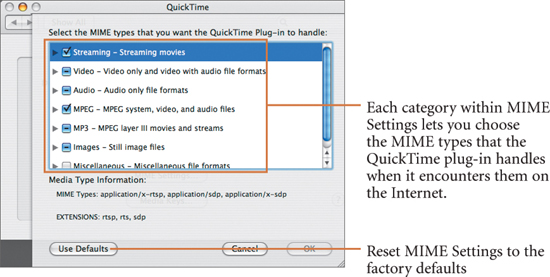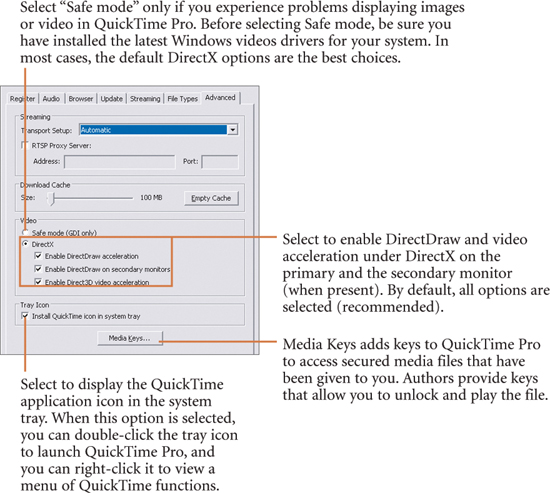Appendix D. QuickTime Preferences
During installation, QuickTime generally optimizes the preference settings based on your current configuration, but you can easily customize the preferences to suit your specific system. You can access and change two sets of preferences within QuickTime Pro: Player preferences and QuickTime preferences. Player preferences control the way the playback application QuickTime Player handles incoming media for recording and outgoing media for playback. The QuickTime preferences control the QuickTime browser plug-in, allow QuickTime registration (turning QuickTime into QuickTime Pro), and set advanced systemwide file-type playback options. By adjusting preferences, you can take control of a wide variety of tasks, from increasing or decreasing the target bandwidth of streaming media to changing the number of default file types (MIME types) that will launch QuickTime Player.
Using Player Preferences
Player preferences are organized into three categories: General, Full Screen, and Recording. These preferences are specific to QuickTime Pro and allow you to control the overall functionality of the application.
General Player Preferences
General settings affect what occurs each time you open a new QuickTime movie.
To open General preferences, choose Edit > Preferences > Player Preferences and click the General tab.
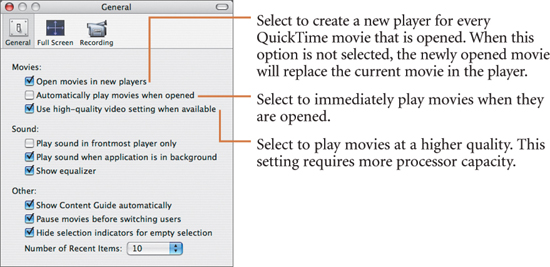

Full Screen Preferences for Mac
Full Screen preferences affect the default settings for QuickTime Pro’s functions when you use View > Full Screen and View > Present Movie. You can also choose when to hide playback controls in Full Screen mode.
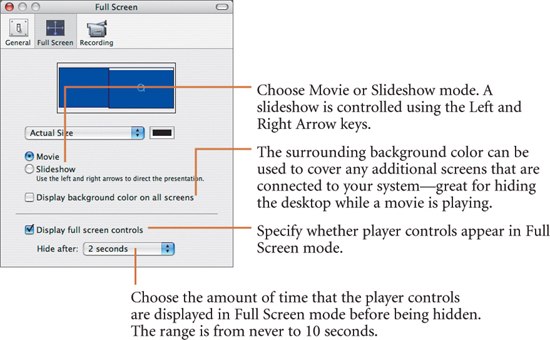
Changes to the surrounding background color using the color well affect only movies played using View > Full Screen. To change the background color when using Present Movie, choose View > Present Movie and use the color well.
Full Screen Preferences for Windows
Full Screen preferences affect the default settings for QuickTime Pro’s functions when you use View > Full Screen and View > Present Movie. You can also choose when to hide playback controls in Full Screen mode. To open Full Screen preferences, choose Edit > Preferences > Player and click the Full Screen tab.

Recording Preferences for Mac
Recording Preferences for the Mac set options for recording directly into QuickTime Pro using a video camera, iSight, or a microphone. Direct recording is a great option for creating video- or audio-based podcasts and for grabbing video from recorded media for use in other projects.

After you’ve chosen your Video Source and Microphone settings, you need to choose a Quality setting to determine the compression method or codec that will be used when recording QuickTime movies. H.264 provides the best results for podcasts, but you should experiment based on your application and needs. For instance, you might choose Native if you want to capture video at the native resolution of your camera: 720 x 480 for DV cameras and 1080 x 1440 for HDV cameras.
Audio Recording Preferences for Windows
Audio Recording preferences for Windows set options for recording sound directly into QuickTime. Direct recording is a great option for creating audio-based podcasts and for grabbing audio from recorded media for use in other projects. To open Audio Recording preferences, choose Edit > Preferences > Player Preferences and click the Audio Recording tab.
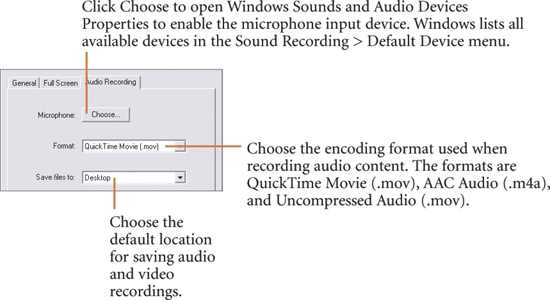
Using QuickTime Preferences
QuickTime preferences let you set overall playback and recording options. For Mac users, they are actually a part of the Macintosh OS X System Preferences.
Mac users can access QuickTime preferences by choosing QuickTime Player > QuickTime Preferences. QuickTime preferences are organized into five categories: Register, Browser, Update, Streaming, and Advanced.
Windows users open QuickTime preferences by choosing Edit > Preferences > QuickTime Preferences. QuickTime preferences are organized into seven tabs: Register, Audio, Browser, Update, Streaming, File Types, and Advanced.
Register Preferences
Register preferences are used to enter your QuickTime Pro registration key and to verify that you are running QuickTime Pro.
Audio Preferences (Windows only)
The Audio preferences for Windows set options for recording and playback for QuickTime applications.
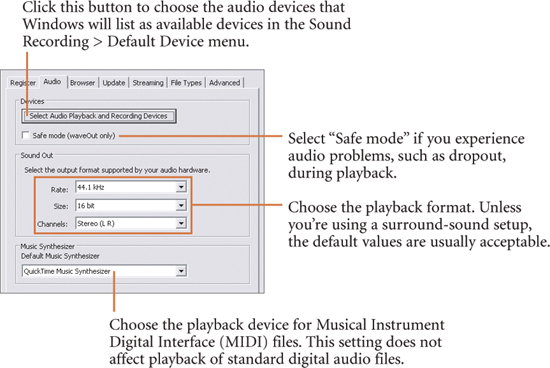
Browser Preferences for Mac
Browser preferences are applied to QuickTime movies that are viewed on the Internet using a web browser. They affect QuickTime browser plug-ins when you view content on the web.
Use Brower preferences to set whether movies play automatically and whether they are saved in a cache (temporary memory), so they won’t need to be downloaded when replayed on the web.

Browser Preferences for Windows
Browser preferences are applied to QuickTime movies that are viewed on the Internet using a web browser. They affect QuickTime browser plug-ins when you view content on the web.
Use Brower preferences to set whether movies play automatically and whether they are saved in a cache (temporary memory), so they won’t need to be downloaded when replayed on the web.

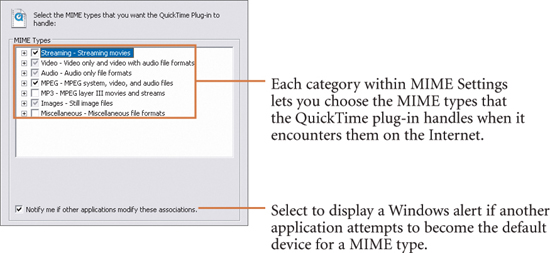
Update Preferences
The Update preferences let you update your QuickTime software and also install additional third-party QuickTime software to extend the functions of QuickTime Pro.
Streaming Preferences for Mac
As with Browser preferences, Streaming preferences affect the way that QuickTime browser plug-ins handle Web content, specifically streaming content. The default streaming speed is Automatic, but you can use the pop-up menu to choose a specific speed based on your connection.
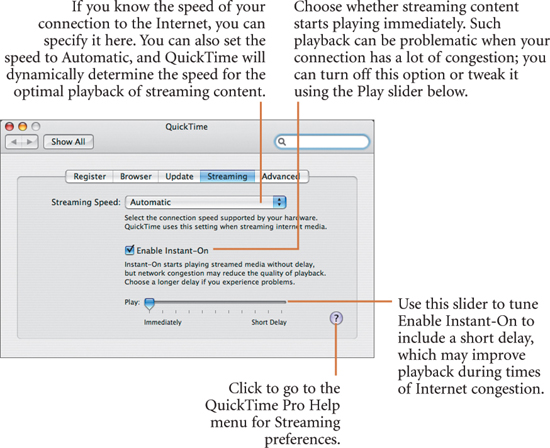
Streaming Preferences for Windows
As with Browser preferences, Streaming preferences affect the way that QuickTime browser plug-ins handle Web content, specifically streaming content. The default streaming speed is Automatic, but you can use the pop-up menu to choose a specific speed based on your connection speed.

File Types Preferences (Windows only)
File Types preferences are available only in QuickTime Pro for Windows. You can set these preferences to assign QuickTime Pro as the default application for opening and playing a variety of media file types.

Advanced Preferences for Mac
Advanced preferences affect the performance and support of the QuickTime browser plug-ins. The main preferences here deal with MIME settings and media keys.
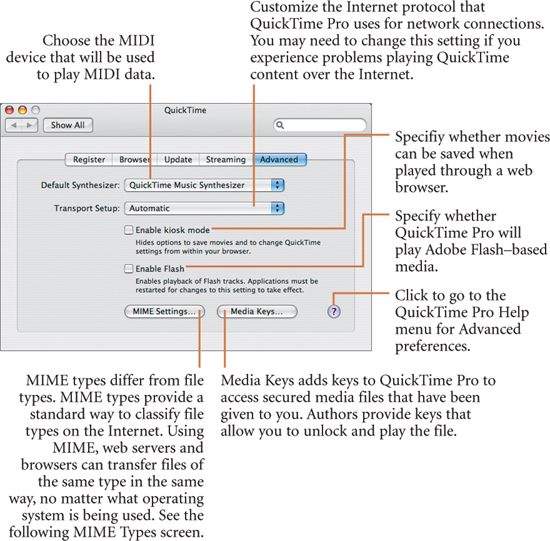
Advanced QuickTime Preferences for Windows
Advanced preferences affect the communication protocols and proxy settings, in addition to cache and video configurations. As with other preferences, the default settings are acceptable in most cases and will not need to be customized.




